What Are Ground Source Heat Pumps and How Do They Work?
- How a closed loop system works
- An overview of ground source heat pumps
- Things to consider before you switch
Low carbon heating comes in many different forms, and a ground source heat pump is one of the best systems you can get. They extract heat from the Earth and use it to warm your heating and hot water. Though they still require electricity to run, they produce up to four times more heat than power consumed.
This article will explain how ground source heat pumps work and look at both their purchase and operational costs. It will then go over the advantages and disadvantages, and explain important points you should be aware of.
Interested in a heat pump? Use our quote comparison tool to find competitive prices in your area. It only takes a minute.
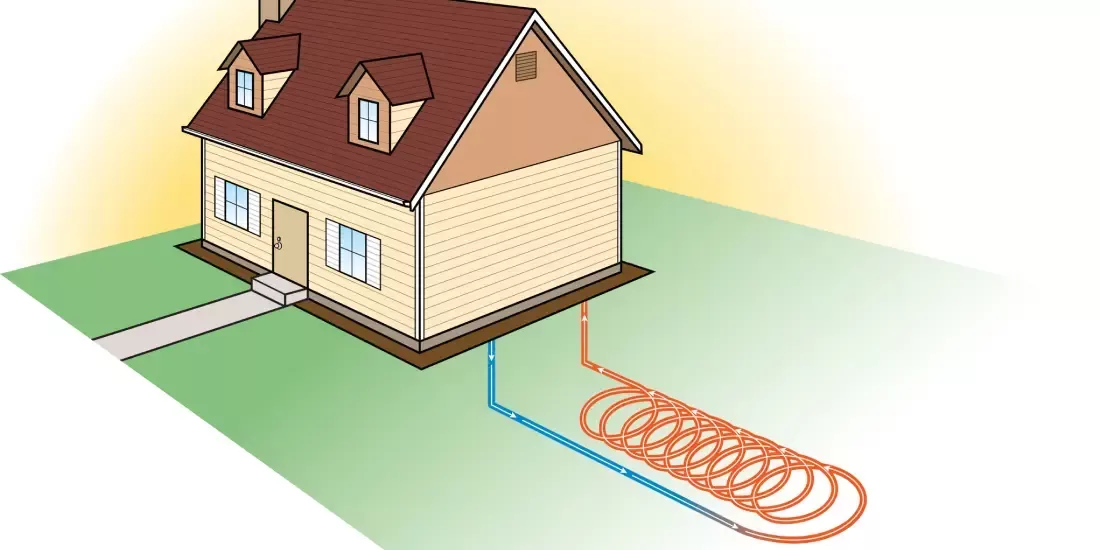
What's On This Page?
Click the links below and head straight to a specific section of the article.
What Is a Ground Source Heat Pump?
All heat pumps transfer heat from one source to another. They are so efficient that they can amplify any natural heat using electrical energy in order to warm up your home. There’s a few different types of ground source heat pump, but we’ll mainly focus on the basic horizontal geothermal closed loop system.
A geothermal heat pump uses natural heat from the ground to do this and can either supply heat to your radiators or underfloor heating. You can also power your hot water supply. Ground temperatures are typically higher than air because heat gets trapped more easily, making ground pumps more energy efficient.
How Do Ground Source Heat Pumps Work?
Underground Coils
Ground types work by pumping a special mix of fluid through a series of underground pipes buried in your garden or outside space. These coils are usually laid in horizontal lanes to maximise the amount of residual heat they can absorb. If there isn’t enough room, vertical boreholes can be drilled instead.
These pipes absorb the naturally occurring heat from the ground and warm up the fluid, which is then transferred to a heat exchanger in the ground source heat pump. This amplifies the heat through a condenser to the point where it can warm your heating and hot water.
Once the fluid has warmed your heating system, it goes through an expansion valve, which condenses the refrigerant. The process then starts all over again, returning through the underground coils to gather more heat.
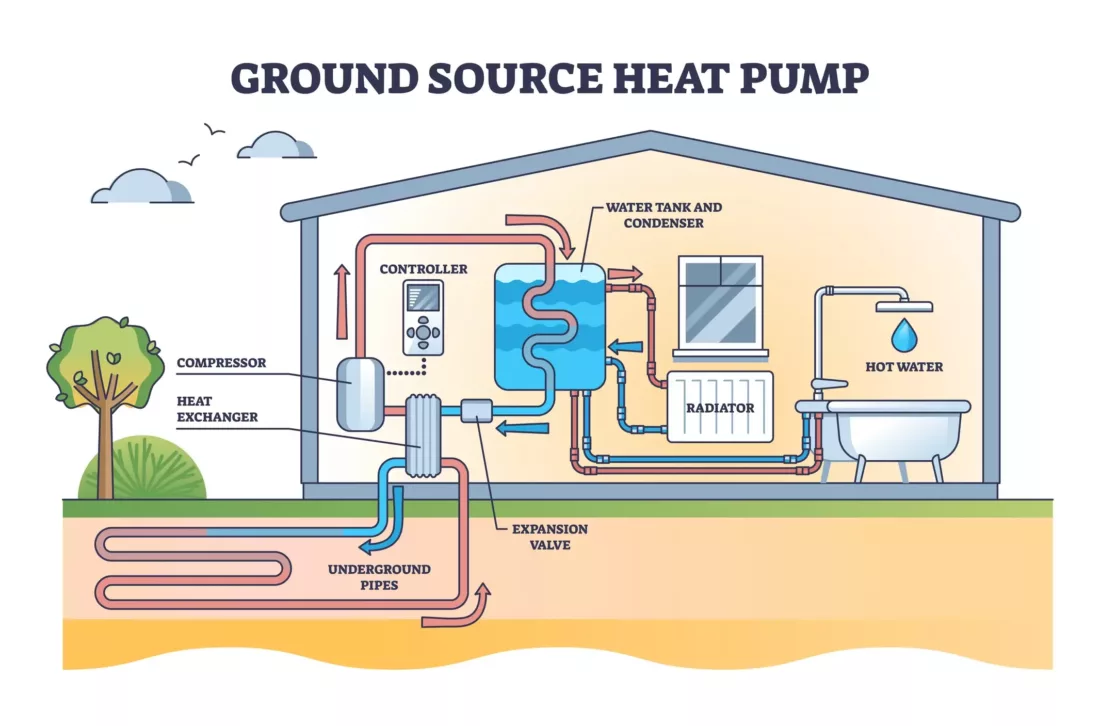
Efficiency and Temperature Output
A ground source heat pump is normally around 350–400% efficient. This means that for every kilowatt of electricity consumed, it can produce 3.5–4kW of heat. While an air source model will have to work much harder in the winter, the ground is normally between 5°C and 15°C throughout the year, making it much easier to harness heat.
Heat pumps work on low flow temperatures, which means they’re not an immediate source of heat. They are able to gradually raise the temperature of your heating and hot water to a maximum of 50°C. For a well insulated home, this will be adequate to maintain desired room temperatures.
Some models are capable of providing hot water on top of central heating, as they are more powerful. Top-of-the-range ground source heat pumps can warm a cylinder to 60°C or higher.
Main Considerations Before You Buy
Space Requirements
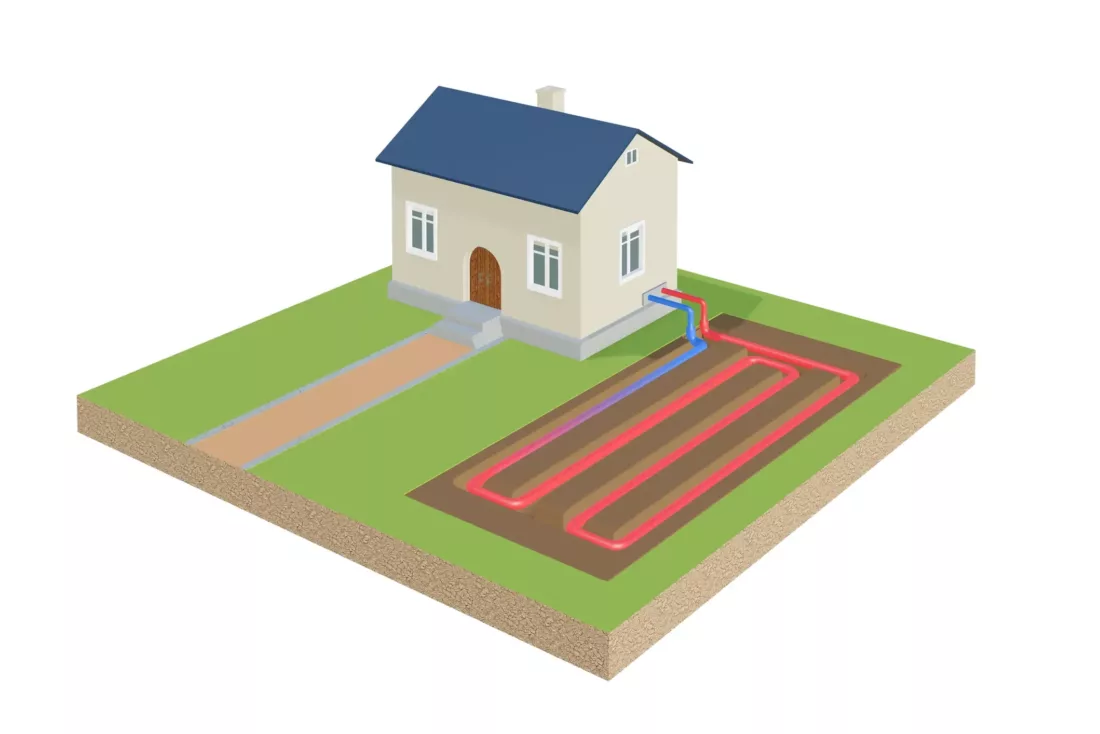
The main issue with heat pumps is that you need the space to lay the external pipework. The longer the pipework, the more heat you’ll be able to generate. If you have a large home with a big heating capacity, you’ll need a lot of room to cover your requirements.
Pipework for a ground source heat pump is usually dug 1.5 metres below the ground’s surface in trenches up and down your garden or outside space. This depth prevents them from being impacted by frost.
If you don’t have an abundance of outside space, you may need to have vertical boreholes installed instead. Bear in mind that the vertical ground source heat pump cost is much higher. These drilled holes go between 75 and 200 metres down. Depending on your heating requirements, you may even need more than one.
If there simply isn’t enough space to cover your heating requirements, you may need a separate electric heater for your domestic hot water supply.
Low Flow Temperatures
Heat pumps work to lower temperatures (typically 35-45°C) than fossil fuel boilers (around 75°C), so your ground source heat pump system will most likely take longer to heat up than what you’re accustomed to.
You may find that you need to operate your heating system for longer in order to achieve desired temperatures. This shouldn’t be a cause for concern though as heat pumps operate much more efficiently than other heating methods.
Low flow temperatures are suited for underfloor heating. As another highly efficient heating method, underfloor heating isn’t meant to be operated any higher than 45°C. This makes it a perfect companion to a ground source heat pump.
Emissions
While heat pumps operate using at least 75% renewable energy, the 25% that’s powered by electricity doesn’t necessarily come from renewable sources. In the UK, not even half of electricity is produced using solar or wind power, which means there are indirect emissions involved.
Unless you’re powering your ground source heat pump using your own solar array, it will remain a low carbon solution instead of a renewable one. Another way to reduce the impact on your conscience is to use a green energy provider who offers 100% green electricity.
Warranty and Lifespan
Generally, a warranty for a heat pump will only last up to 10 years. With regular maintenance, a ground source heat pump can operate for at least 20 years or even more. Some of the components are capable of lasting for 50 years, which can save you money on replacements.
Regular maintenance is essential to keeping your heating system operational for longer. It’s considered good practice to pay for a service once a year. This is normally also a condition of the warranty to keep it valid.
How Much Do Ground Source Heat Pumps Cost?
Which? estimates the average cost of a ground source heat pump to be around £24,000. However, this can vary wildly depending on multiple factors.
These include:
Trench or borehole system
Model (Vaillant heat pumps)
Heating requirements
Size of property
Heating system upgrades (bigger radiators or underfloor heating installation)
A bigger ground source heat pump system is more invasive and requires additional costs. Your existing heating system may also need to be updated to compensate for the lower pressures heat pumps work at. Greater surface areas are needed, so either larger radiators should be fitted or underfloor heating instead. This will affect your total bill.
According to data from MCS, the average cost of these heat pumps in 2023 was £25,868. You can see how the price fluctuated throughout the year in the graph below.
Boiler Upgrade Scheme
Fortunately, replacing a fossil fuel boiler with a ground source heat pump qualifies you for the Boiler Upgrade Scheme. Homeowners in England and Wales are eligible for £7,500 off the installation. This reduces the MCS average in 2023 to £18,368.
What Are the Running Costs?
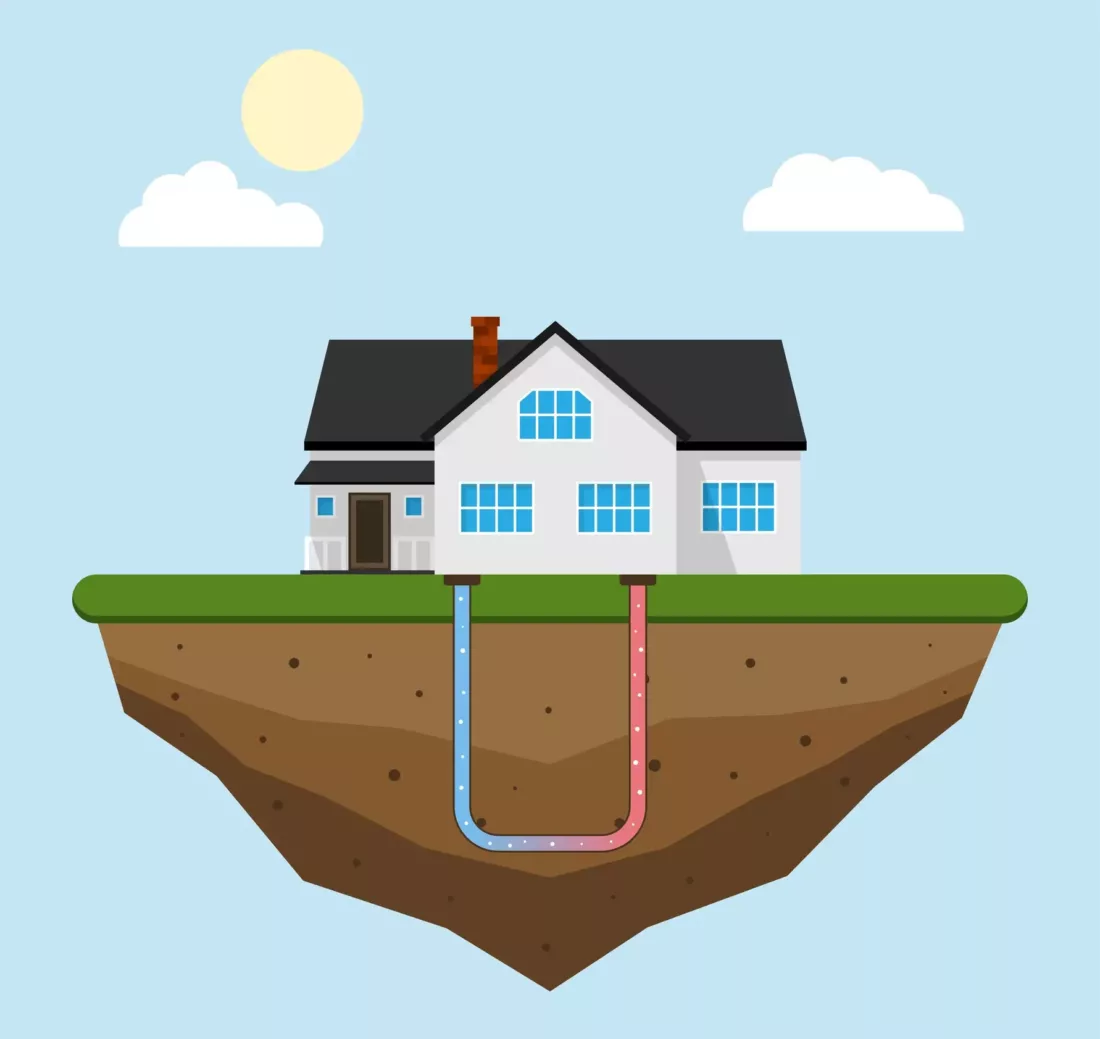
Operational costs of a ground source heat pump will fluctuate every time the energy price cap is updated. It also depends on which system you had previously and how well insulated your property is.
If you take the average annual gas use of a home (11,500kWh) and multiply it by the efficiency of your current gas boiler (e.g., 85%), you get a base figure to work with. In this example, it’s 9,775kWh.
Take this and divide it by the efficiency of your ground source heat pump (COP). You can then multiply it by the unit price of electricity to get a rough indication of how much it will cost to run.
In this example, 9,775kWh ÷ 4 = 2,444kWh.
2,444kWh x £0.24 = £587.
This means a ground source heat pump will only cost you £587 a year to run.
Lower Energy Bills
Because of their super high efficiencies, the main benefit of a ground source heat pump is how much it can lower your heating bills by.
Data from Energy Saving Trust, based on the April 2024 price cap, puts the highest yearly savings at £1,900, and the lowest at £50. This can save up to 7,000kg of CO₂ equivalent, making them much more beneficial than all other heating systems.
Solar Power
Theoretically, you can completely run your ground source heat pump for free using solar energy. In reality, you may not have a solar array big enough to cover the entire operational need, but you can always supplement it. Running a heat pump on solar panels simply reduces your energy bills even more.
Insulation
The final point about heat pumps is that they only work with a home that is properly insulated in the first place. Good insulation helps reduce operational costs as it’s better at heat retention and stops your heat pump from working as hard to maintain its set temperature.
If your home isn’t yet ready for a heat pump, it needs to be sufficiently insulated first. This is why some installations can be more expensive than others.
Ground Source Heat Pump Pros and Cons
The main advantages of a ground source heat pump are in how you can have low energy bills and potentially free heating by making use of solar energy. A fully renewable heating system is possible, significantly reducing your carbon footprint.
The disadvantages of a ground source heat pump are mainly to do with how expensive they are to install and how much room they require. Even with the Boiler Upgrade Scheme discount, these systems are at least three times as much as the grant.
Convinced by the benefits of a ground source heat pump? Find out how much you’d pay by clicking on the button below.
Related articles
View all Heat Pump articles
Samsung Air Source Heat Pumps: Overview and Costs

Mitsubishi Air Source Heat Pumps: Overview and Costs
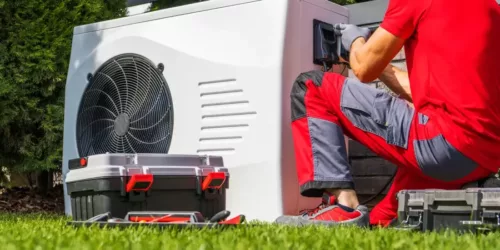
The Cost of an Air Source Heat Pump Service
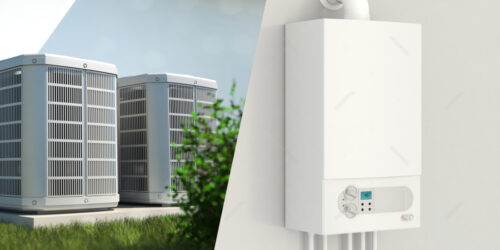
Heat Pump vs Gas Boiler - What's Better?
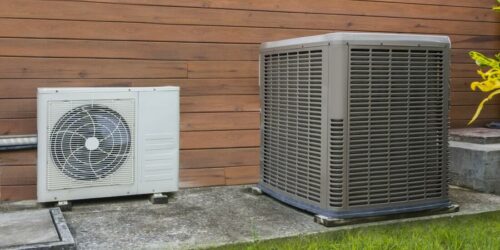
Different types of heat pumps: what’s available?
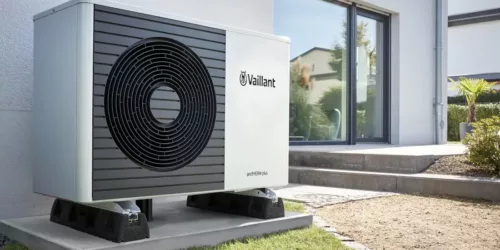
The Ultimate Guide to Vaillant Heat Pumps
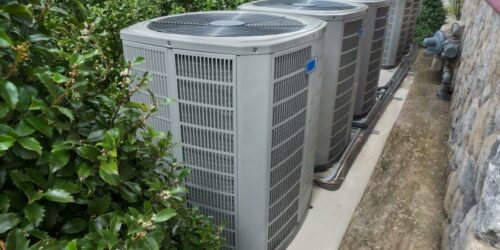
How Do Air Source Heat Pumps Work?







